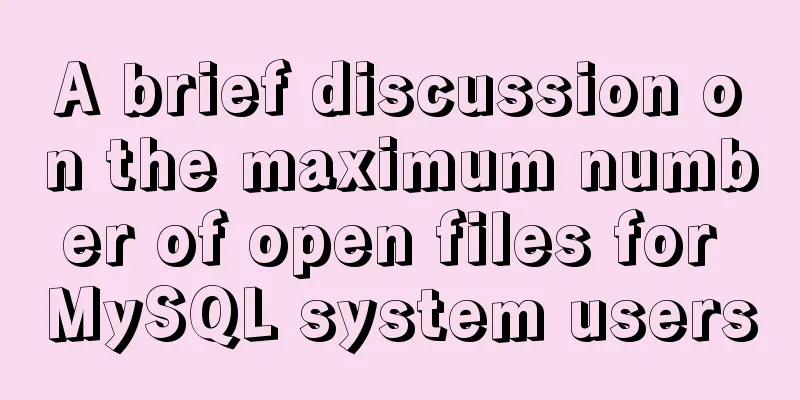MySQL 8.0.12 installation graphic tutorial

|
MySQL8.0.12 installation tutorial, share with everyone. 1. Installation 1. Download MySQL 8.0.12 from the Internet, download address
2. After downloading, unzip it The path I unzipped is: D:\Java\mysql-8.0.12-winx64 3. Configuration Files First, check whether there is a my.ini file in the decompressed path. If not, create a new one with the following content: [mysqld] # Set port 3306 port=3306 # Set the installation directory of mysql to basedir=D:\Java\mysql-8.0.12-winx64 # Set the storage directory of mysql database data datadir=D:\Java\mysql-8.0.12-winx64\data # Maximum number of connections allowed max_connections=200 # The number of connection failures allowed. This is to prevent someone from trying to attack the database system from this host max_connect_errors = 10 # The default character set used by the server is UTF8 character-set-server=utf8 # The default storage engine that will be used when creating a new table default-storage-engine=INNODB # By default, the "mysql_native_password" plug-in is used for authentication. default_authentication_plugin=mysql_native_password [mysql] # Set the default character set of the mysql client to default-character-set=utf8 [client] # Set the default port used by the mysql client to connect to the server port = 3306 default-character-set=utf8 4. Database Configuration Enter cmd with administrator privileges ( if you do not have administrator privileges, there will be problems ), enter the bin directory of the MySQL installation directory
Then enter mysqld --initialize --console and the following screen will appear. The one marked in red is the initial password of the database root user. Be sure to remember it as you will need it for logging in later. Of course, if you accidentally turn it off or forget it, delete the initialized data directory and execute the initialization command again to regenerate it.
Then enter mysqld --install to install the MySQL service, and enter net start mysql to start the service. Note: mysqld --remove is to uninstall the MySQL service, and net stop mysql is to stop the service.
5. Enter the database configuration After entering mysql -u root -p, you will be asked to enter the password. The password is the password you were asked to remember before. After entering it correctly, the following interface will appear, indicating that you have entered the MySQL command mode.
Then change the password and enter ALTER USER 'root'@'localhost' IDENTIFIED WITH mysql_native_password BY 'new password'; the following interface appears, indicating that the change is successful.
At this point, the MySQL8.0.12 database has been installed. 2. Database related configuration View the default database: show databases; Select mysql database: use mysql View the default MySQL user: select host, user, authentication_string, plugin from user;
Create a new user: CREATE USER 'username'@'hostname' IDENTIFIED WITH mysql_native_password BY 'password'; Authorize the new user: GRANT ALL PRIVILEGES ON *.* TO 'user name'@'host name'; Refresh permissions: FLUSH PRIVILEGES;
3. Detailed explanation of the problem 1. MySQL8.0.12 cannot connect to Navicat Reason: The encryption rules used by MySQL 8.0 and MySQL 5.0 are different, so Navicat cannot be opened. You can view the password rules by selecting host, user, authentication_string, plugin from user;.
As shown above, the plugin column is the encryption rule for the corresponding user. You can see that the encryption rule for my root user is: mysql_native_password. This is because I have already set it. The default is: caching_sha2_password, so we only need to change the default caching_sha2_password to mysql_native_password. Solution: Enter ALTER USER 'root'@'localhost' IDENTIFIED WITH mysql_native_password BY 'new password'; to modify the encryption rules and password of the root user. 2. Authorization error, showing You are not allowed to create a user with GRANT Cause: There are many tutorials online saying that when "The user specified as a definer ('root'@'%') does not exist" appears, it means that the root user does not have sufficient permissions and you only need to execute GRANT ALL ON *.* TO 'root'@'%';. However, the error message "You are not allowed to create a user with GRANT" often appears. This is because the percent sign in @ '%' in the statement GRANT ALL ON *.* TO 'root'@ '%' is actually the name of the host corresponding to the root user. Many people do not notice that their root user actually corresponds to localhost, and directly execute the above statement, which is why an error occurs. Solution: Just change the % in GRANT ALL ON *.* TO 'root'@'%'; to the corresponding host name, and finally refresh the permissions FLUSH PRIVILEGES ;. Special note: It is said on the Internet that % means wildcard all hosts, but the operation was not successful. I don’t understand why. I guess it may be related to MySQL version 8.0.
The above is the full content of this article. I hope it will be helpful for everyone’s study. I also hope that everyone will support 123WORDPRESS.COM. You may also be interested in:
|
<<: A brief analysis of different ways to configure static IP addresses in RHEL8
>>: Vue implements a simple shopping cart example
Recommend
Vue3 draggable left and right panel split component implementation
Table of contents Breaking down components Left P...
Linux common commands chmod to modify file permissions 777 and 754
The following command is often used: chmod 777 文件...
Summary of MySQL date and time functions (MySQL 5.X)
1. MySQL gets the current date and time function ...
Detailed explanation of the pitfalls of mixing MySQL order by and limit
In MySQL, we often use order by for sorting and l...
How to underline the a tag and change the color before and after clicking
Copy code The code is as follows: a:link { font-s...
JavaScript design pattern learning adapter pattern
Table of contents Overview Code Implementation Su...
Example code for using @media in CSS3 to achieve web page adaptation
Nowadays, the screen resolution of computer monit...
Example of how to embed H5 in WeChat applet webView
Preface WeChat Mini Programs provide new open cap...
Use CSS to achieve 3D convex and concave effects on images (convex out of the frame or concave in the frame)
Ⅰ. Problem description: Use CSS to achieve 3D con...
Vue implements the packaging and use of components to control the number of goods
The encapsulation and use of Vue's control pr...
Simple usage examples of MySQL custom functions
This article uses examples to illustrate the usag...
HTML solves the problem of invalid table width setting
If you set the table-layer:fixed style for a tabl...
Web design tips on form input boxes
This article lists some tips and codes about form...
The difference and usage of Vue2 and Vue3 brother component communication bus
Table of contents vue2.x vue3.x tiny-emitter plug...
Vue implements a draggable tree structure diagram
Table of contents Vue recursive component drag ev...





















